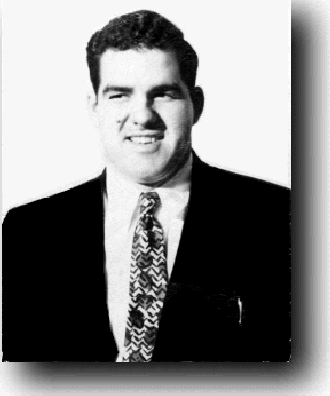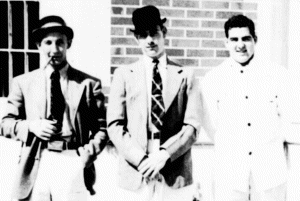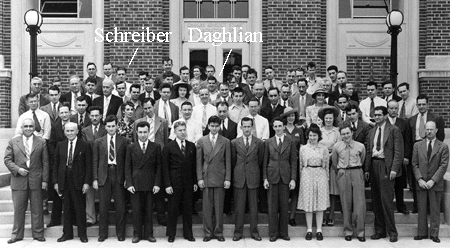Daghlian Biography
 Born in Waterbury, CT
in 1921, Harry K. Daghlian, Jr, was the first child of Harry
(Haroutune) Krikor Daghlian and Margaret Rose Daghlian (née Currie). Soon
thereafter, the Daghlian family moved to the small coastal
community of New London, where young Harry received all of his primary and
secondary school education, while his father worked as an
X-ray technician and later became supervisor of the X-ray
laboratory at the Lawrence and Memorial Hospital.
Born in Waterbury, CT
in 1921, Harry K. Daghlian, Jr, was the first child of Harry
(Haroutune) Krikor Daghlian and Margaret Rose Daghlian (née Currie). Soon
thereafter, the Daghlian family moved to the small coastal
community of New London, where young Harry received all of his primary and
secondary school education, while his father worked as an
X-ray technician and later became supervisor of the X-ray
laboratory at the Lawrence and Memorial Hospital.
As a student
at Harbor Elementary School, the young Harry Daghlian played
the violin in the school orchestra and seemed to be
interested in everything at an early age, winning a silver
cup as the most outstanding student at Harbor. Undoubtedly,
his penchant for mathematics and science was engendered and
fostered by his parents and his uncle, Dr. Garabed K. Daghlian, who
was a professor of physics and astronomy at
Connecticut College (CC) located on the outskirts of New London.
Dr. Daghlian became known as the "father" of the Physics and Astronomy
Department at CC and he was a frequent speaker for local civic groups on a
variety of
subjects ranging from the economic depression of that time to
celestial comets.

In 1938,
Daghlian graduated first in his class in mathematics from
Bulkeley High School and started his undergraduate studies at
MIT at the age of 17. After two years, however, his
fascination with physics, particularly in the emerging field
of particle physics, led him to transfer to the Lafayette,
Indiana campus of Purdue University. There, he obtained a
Bachelor of Science degree in the spring of 1942 and started
his graduate fellowship studies, which included a stint as a
physics instructor.
[
Inset
: Daghlian (extreme right) with two friends at Purdue. To earn
extra money, Daghlian waited tables, as suggested by his attire.]

Nineteen
forty three would prove to be a pivotal year for five Purdue
physicists and their families. In the spring of that year,
Oppenheimer was busily recruiting scientific personnel for
Los Alamos and the majority of early recruits consisted of
scientists with whom he had previous or ongoing
collaborations. It was in this context that Marshall Holloway
was invited to give a lecture at Los Alamos in the spring of
1943, and Oppenheimer used that occasion to recruit
Holloway's group from Purdue. On returning, Holloway
announced his intentions to transfer to Los Alamos after
completion of cross-section studies of tritium and deuterium
(T-D cross-sections). In addition to Holloway, his group
consisted of three senior-level investigators - Charles
"Charlie" P. Baker, Lionel Daniel Percival
"Perc" King and Raemer E. Schreiber. A young
graduate student, Harry K. Daghlian Jr., would help in finalizing the Purdue
studies,
and would join them in Los Alamos at a later date.
[
Inset
: Group photo of attendees
at the Conference on Problems of Modern Physics (19 and 20 June, 1942) held at
Purdue on the occasion of dedicating a new physics building.]
Previous Page

 Next Page
Next Page
Page Top

 Home
Home
 Born in Waterbury, CT
in 1921, Harry K. Daghlian, Jr, was the first child of Harry
(Haroutune) Krikor Daghlian and Margaret Rose Daghlian (née Currie). Soon
thereafter, the Daghlian family moved to the small coastal
community of New London, where young Harry received all of his primary and
secondary school education, while his father worked as an
X-ray technician and later became supervisor of the X-ray
laboratory at the Lawrence and Memorial Hospital.
Born in Waterbury, CT
in 1921, Harry K. Daghlian, Jr, was the first child of Harry
(Haroutune) Krikor Daghlian and Margaret Rose Daghlian (née Currie). Soon
thereafter, the Daghlian family moved to the small coastal
community of New London, where young Harry received all of his primary and
secondary school education, while his father worked as an
X-ray technician and later became supervisor of the X-ray
laboratory at the Lawrence and Memorial Hospital.



 Next Page
Next Page

 Home
Home